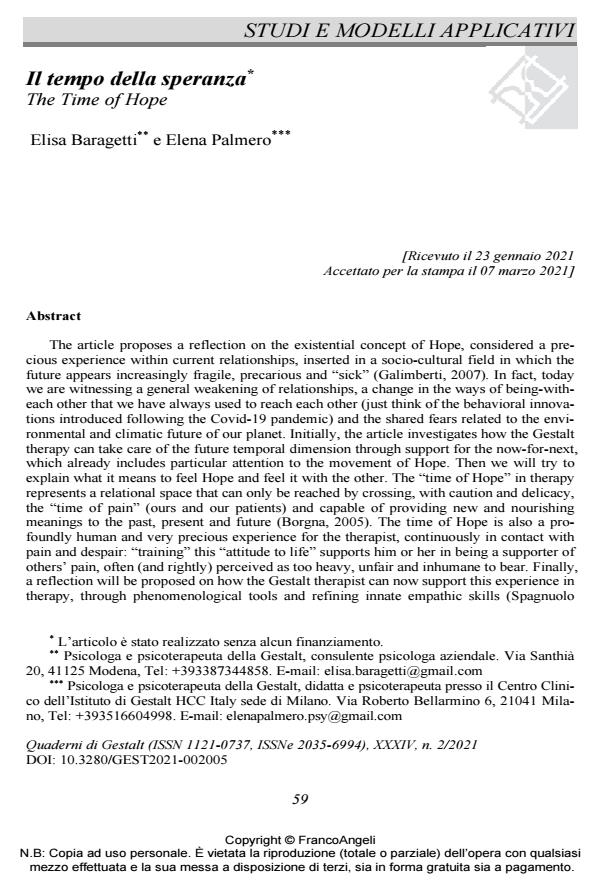Il tempo della speranza
Titolo Rivista QUADERNI DI GESTALT
Autori/Curatori Elisa Baragetti, Elena Palmero
Anno di pubblicazione 2021 Fascicolo 2021/2
Lingua Italiano Numero pagine 12 P. 59-70 Dimensione file 246 KB
DOI 10.3280/GEST2021-002005
Il DOI è il codice a barre della proprietà intellettuale: per saperne di più
clicca qui
Qui sotto puoi vedere in anteprima la prima pagina di questo articolo.
Se questo articolo ti interessa, lo puoi acquistare (e scaricare in formato pdf) seguendo le facili indicazioni per acquistare il download credit. Acquista Download Credits per scaricare questo Articolo in formato PDF

FrancoAngeli è membro della Publishers International Linking Association, Inc (PILA)associazione indipendente e non profit per facilitare (attraverso i servizi tecnologici implementati da CrossRef.org) l’accesso degli studiosi ai contenuti digitali nelle pubblicazioni professionali e scientifiche
The article proposes a reflection on the existential concept of Hope, considered a precious experience within current relationships, inserted in a socio-cultural field in which the future appears increasingly fragile, precarious and "sick" (Galimberti, 2007). In fact, today we are witnessing a general weakening of relationships, a change in the ways of being-with-each oth-er that we have always used to reach each other (just think of the behavioral innovations intro-duced following the Covid-19 pandemic) and the shared fears related to the environmental and climatic future of our planet. Initially, the article investigates how the Gestalt therapy can take care of the future temporal dimension through support for the now-for-next, which already includes particular attention to the movement of Hope. Then we will try to explain what it means to feel Hope and feel it with the other. The "time of Hope" in therapy represents a rela-tional space that can only be reached by crossing, with caution and delicacy, the "time of pain" (ours and our patients) and capable of providing new and nourishing meanings to the past, present and future (Borgna, 2005). The time of Hope is also a profoundly human and very precious experience for the therapist, continuously in contact with pain and despair: "training" this "attitude to life" supports him or her in being a supporter of others’ pain, often (and right-ly) perceived as too heavy, unfair and inhumane to bear. Finally, a reflection will be proposed on how the Gestalt therapist can now support this experience in therapy, through phenomeno-logical tools and refining innate empathic skills (Spagnuolo Lobb, 2017). In particular, the ar-ticle focuses on the importance of respecting the "right time", necessary in therapy to provide the patient and therapist with the opportunity to feel pain together without running away from it: an essential ingredient to achieve a reworking of all "times of life", through the magnifying glass of Hope.
Parole chiave:Hope, time, contact-border contact, therapeutic relationship, psychotherapy.
- Essere coppia in-fertile: la riscoperta della vitalità come fattore terapeutico Valentina Foti, Susanna Marotta, in QUADERNI DI GESTALT 2/2024 pp.79
DOI: 10.3280/GEST2023-002006
Elisa Baragetti, Elena Palmero, Il tempo della speranza in "QUADERNI DI GESTALT" 2/2021, pp 59-70, DOI: 10.3280/GEST2021-002005